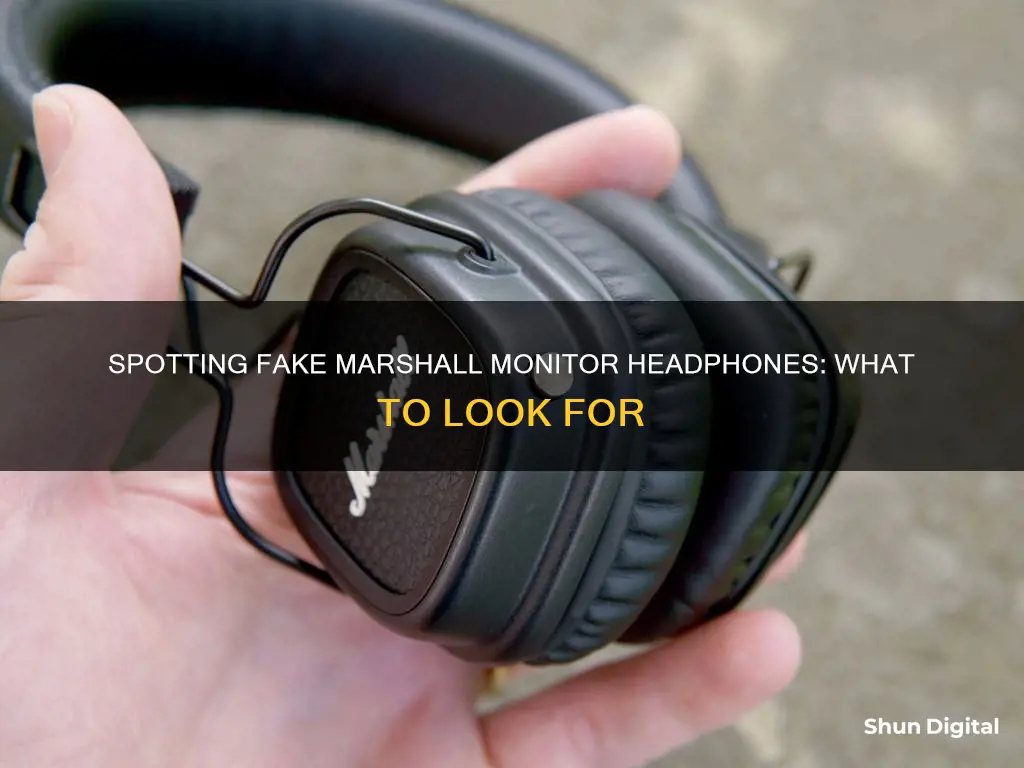
If you're a music lover, you'll know that Marshall is a trusted brand when it comes to audio equipment. However, with the rise of online shopping, it's important to be vigilant about fake products. In this article, we'll be discussing how to spot fake Marshall Monitor headphones so that you can make a safe purchase. From the quality of the sound to the details of the design, we'll cover the key signs to look out for to ensure you're getting an authentic Marshall product. So, whether you're a seasoned audio enthusiast or just starting out, stay tuned for a comprehensive guide to avoiding counterfeit Marshall Monitor headphones.
| Characteristics | Values |
|---|---|
| USB type-A connector | Black insert, not white |
| Metal spring on the audio cable | No gaps |
| Audio connector | Should stick out a bit, not be flush with the case |
| Wires that go from the cups | Thicker, with 6-7 turns, not 4-5 |
| Sound quality | No static noise in the right cup |
| Barcode on the box | 73400553329966 |
| MODEL | MONITOR BLUETOOTH |
| IC | 11153A-MONITOR |
| FCC ID | 2AAGF-MONITOR |
| QR code | 1702A002533 |
| INPUT | 5V 500mA |
| Small chip | PAMP8908 AUB8B (stereo headphone amplifier) |
| Large chip | VIMICRO WX WS9623ADSFF 25PC7GAT 1301743 (Bluetooth Headset IC) |
| Battery | JEZ 602040 3.7V 400 mAh |
What You'll Learn

Check the USB type-A connector colour
When examining the USB type-A connector of your Marshall Monitor Bluetooth Headphones, be sure to pay close attention to the colour of the insert. Authentic Marshall headphones will have a black insert, whereas fake headphones will have a white insert. This is a subtle but important detail to look out for when trying to spot a fake.
The USB type-A connector is a common feature on many electronic devices, including headphones. It is used for charging and data transfer. On the Marshall Monitor Bluetooth Headphones, the connector is located on the charging cable that comes with the headphones. To check the colour of the insert, simply plug the cable into the headphones and take a close look at the connector. The insert is the small piece inside the connector where the cable meets the headphones.
It is important to be aware of this detail, as purchasing fake headphones may result in a lower-quality product that does not meet the standards of the authentic Marshall brand. The sound quality of fake headphones may be inferior, and they may also have connectivity issues or other technical problems. Therefore, it is worth taking the time to carefully inspect the USB type-A connector colour before purchasing or using the headphones.
In addition to checking the USB type-A connector colour, there are several other ways to spot fake Marshall Monitor Bluetooth Headphones. These include examining the metal spring on the audio cable, the audio connector, the wires that go from the cups, and the overall sound quality. By being vigilant and checking for these signs, you can help ensure that you are getting a genuine pair of Marshall headphones.
Selecting a Monitor: Guide to Directing Program Displays
You may want to see also

Inspect the metal spring on the audio cable
Inspecting the metal spring on the audio cable is a crucial step in spotting fake Marshall Monitor headphones. Here are some detailed instructions to help you with the inspection process:
Firstly, carefully examine the metal spring on the audio cable of the headphones. Look for any signs of stretching or gaps in the spring. On genuine Marshall Monitor headphones, the metal spring should be tightly coiled without any noticeable gaps. If you see any stretching or gaps, this is a strong indicator that the headphones are fake.
Next, pay attention to the overall quality of the metal spring. Genuine Marshall headphones are known for their high-quality construction. Look for any imperfections, such as uneven coils, loose ends, or rough manufacturing. A genuine Marshall headphone cable should have a smooth and consistent spring with no visible defects.
Another aspect to inspect is the colour of the metal spring. Typically, the metal spring on Marshall Monitor headphones should have a metallic silver or gold finish. If the colour looks faded, discoloured, or significantly different from the authentic product, this could be an indication of a counterfeit product.
It is also important to examine the functionality of the metal spring. The spring should provide flexibility and extend smoothly when pulled. If the spring feels stiff, difficult to extend, or returns to its original position too quickly, this could be a sign of a substandard spring used in fake headphones.
Additionally, compare the diameter of the metal spring to that of an authentic Marshall Monitor headphone cable. If the diameter of the spring is significantly different, it may be a sign of a counterfeit product. The diameter measurement can be tricky, so make sure to use a precise tool for accuracy.
Lastly, check for any branding or markings on the metal spring. Genuine Marshall headphones may have subtle branding, such as an engraved logo or model number, on the spring or its components. If you see any suspicious markings or a complete absence of branding, this could be an indication of a fake product.
Remember, when inspecting the metal spring on the audio cable, it is important to be vigilant and trust your instincts. Compare the headphones to authentic product images and reviews to help you identify any discrepancies. By following these detailed instructions, you can confidently assess the authenticity of Marshall Monitor headphones and make an informed decision.
Adjusting Brightness on Your ASUS Monitor: A Simple Guide
You may want to see also

Examine the audio connector
When examining the audio connector of the Marshall Monitor Bluetooth headphones, there are a few key things to look out for to spot a fake. Firstly, the USB Type-A connector of the genuine headphones should have a black insert, whereas the fake ones tend to have a white insert. Secondly, the metal spring on the audio cable of the authentic headphones should be tightly coiled without any gaps, whereas the counterfeit ones often have stretched springs with visible gaps.
Another tell-tale sign is that the audio connector of the genuine headphones should protrude slightly from the case, whereas on the fake ones, it is usually flush with the case and does not extend outwards. In addition, the wires extending from the headphone cups on the authentic product will be thicker and have more coils, typically with 6 to 7 turns, compared to the counterfeit version, which may only have 4 to 5 turns.
It is important to pay close attention to these subtle differences when examining the audio connector to increase your chances of spotting a fake pair of Marshall Monitor Bluetooth headphones.
Finding Elusive Mouse Pointers on Multiple Monitors
You may want to see also

Observe the wires from the cups
When observing the wires from the cups of the Marshall Monitor Bluetooth headphones, there are a few signs that can help you spot a fake. Firstly, examine the number of turns in the wire. Authentic Marshall headphones should have 6-7 turns, while fakes often have only 4-5 turns. In addition, the wires on counterfeit headphones tend to be thinner than those on genuine ones.
Another detail to look out for is the metal spring on the audio cable. On genuine Marshall headphones, the metal spring should be tightly coiled without any gaps, whereas on fakes, the spring may appear stretched with noticeable spaces between the coils.
It is also important to inspect the USB connector type. The original Marshall headphones feature a USB Type-A connector with a black insert, whereas fakes may have a white insert instead of black.
By carefully observing these details, you can increase your chances of spotting a counterfeit pair of Marshall Monitor headphones. Remember to look for multiple indicators, as counterfeiters may vary their methods, and no single indicator is definitive proof of authenticity or counterfeiting.
Is Your Email Being Watched? Here's How to Tell
You may want to see also

Assess the sound quality
When it comes to assessing the sound quality of Marshall Monitor headphones, there are a few key things to listen out for to ensure you have an authentic pair.
Firstly, Marshall is known for its impressive sound quality, so you should expect music to sound punchy and immersive, with clear textures and instruments. The bass should be strong without being overpowering, and the mid-frequency scoop should sound clean and pleasant, especially when listening to rock, blues, audiobooks, and podcasts.
One way to spot fake Marshall Monitor headphones is to pay attention to the bass response. If the bass sounds weak or lacking, it could be a sign of a fake pair. Additionally, check for any static noise, particularly in the right ear cup, as this is another indicator of a counterfeit product.
Another way to assess sound quality is to test the Bluetooth connection. Authentic Marshall Monitor headphones should offer good wireless audio quality, with aptX Bluetooth technology providing a seamless listening experience. If you notice frequent disconnects or audio crackling, this could be a sign of a fake product.
It is also important to test the volume levels. Fake Marshall Monitor headphones may have inadequate maximum volume, falling short of what you would expect from authentic headphones.
Lastly, the design of the headphones can impact the sound quality. Ensure the ear cups fit snugly over your ears, creating a good seal for optimal sound isolation. This will help block out ambient noise and enhance your listening experience.
By paying attention to these sound quality indicators, you can better assess whether your Marshall Monitor headphones are authentic or fake.
LCD HD Monitors: Better Than SyncMaster 2693HM?
You may want to see also







